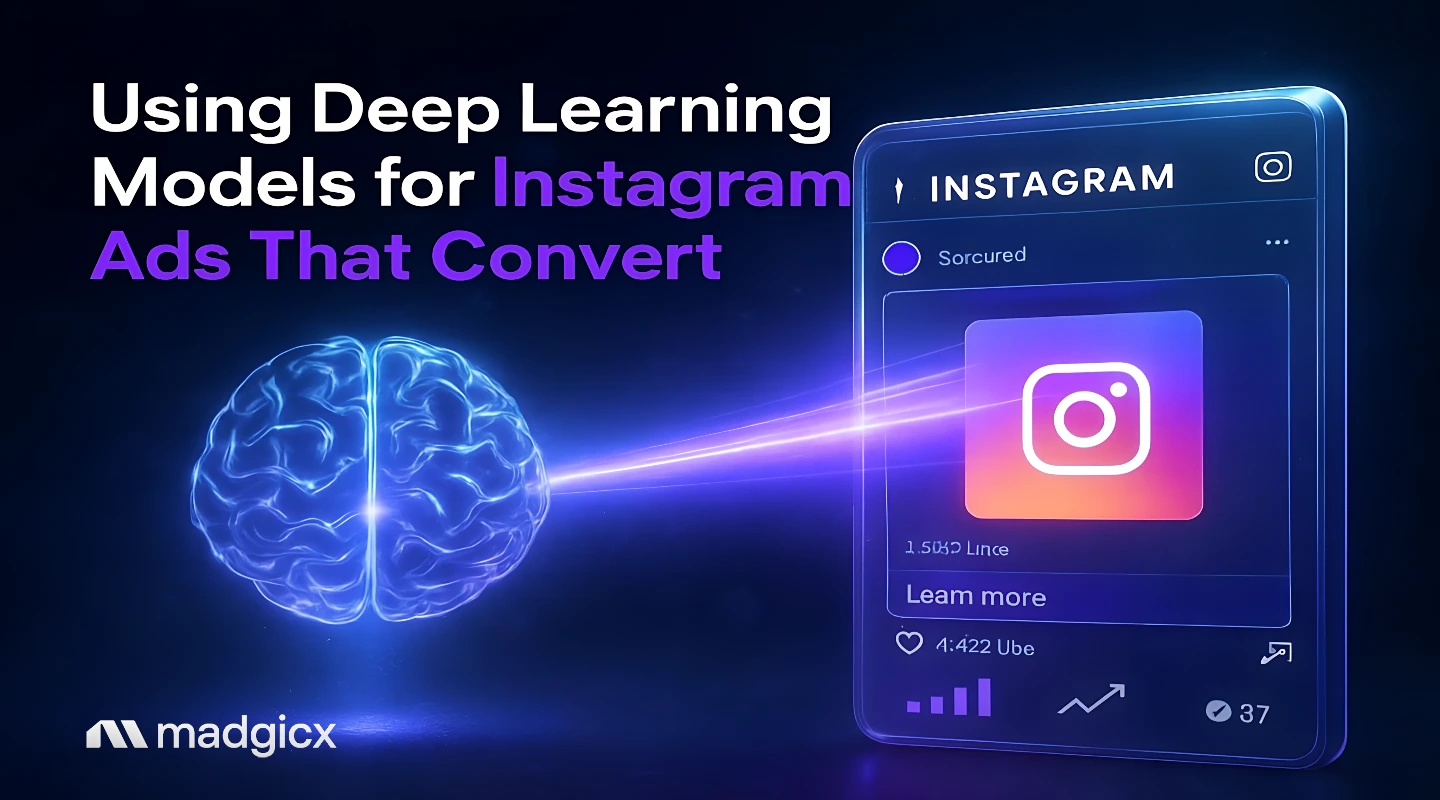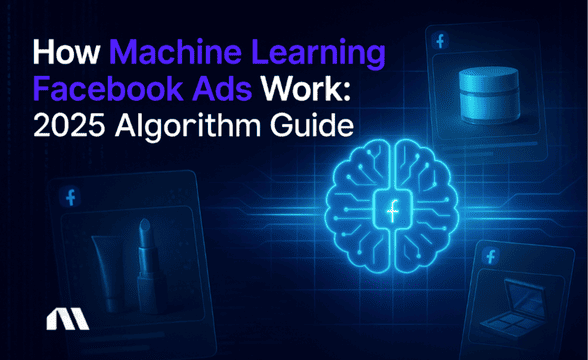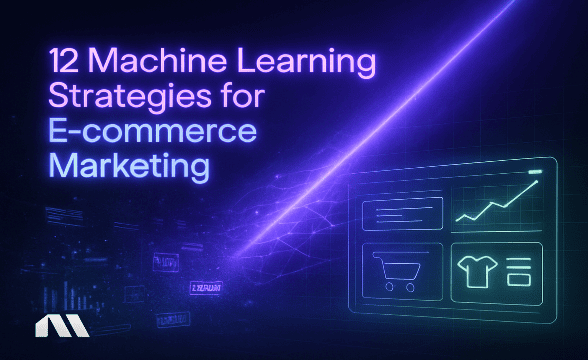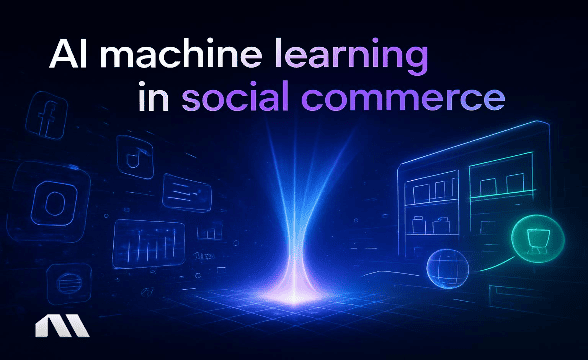Learn how to use deep learning models for Instagram ads that deliver higher CTRs. Complete guide with CNN, RNN strategies, and real optimization workflows.
Picture this: While most marketers are still manually tweaking their Instagram ads at 2 AM, wondering why their CTR dropped again, performance marketers using deep learning models are sleeping soundly. Their campaigns are continuously optimizing with AI assistance, delivering 41% higher click-through rates and 40% better conversion rates.
Here's the thing that'll blow your mind: Instagram's algorithm processes over 1.47 billion daily active users through incredibly sophisticated neural networks. Smart performance marketers have caught on and are now leveraging similar deep learning approaches for their ad targeting and optimization – essentially using AI optimization to work with platform algorithms.
Using deep learning models for Instagram ads is the systematic application of multi-layered neural networks to automatically analyze user behavior patterns, optimize ad targeting, predict engagement outcomes, and adjust campaign parameters in real-time with minimal manual oversight required. Think of it as having a team of data scientists working continuously to improve performance from your ad spend.
This guide breaks down exactly how to implement deep learning models for your Instagram ads. You'll get neural network selection strategies, performance optimization workflows, and real Madgicx case studies with actionable steps you can start using today.
What You'll Master in This Guide
By the time you finish reading this, you'll know exactly how to:
- Select the right deep learning model for your Instagram ad objectives (CNN vs RNN vs Transformer architectures)
- Implement a step-by-step workflow for deep learning ad optimization with real performance benchmarks
- Deploy advanced targeting strategies using neural networks that reduce budget waste by up to 22%
- Leverage Madgicx's proprietary framework that uses advanced optimization approaches
Understanding Deep Learning Models for Instagram Ads
Let's start with the fundamentals. Deep learning models for digital advertising are artificial neural networks with multiple hidden layers that automatically learn complex patterns from large datasets. They make predictions and optimizations with minimal manual programming for each scenario.
Here's why this matters for your Instagram campaigns: Traditional rule-based optimization can handle maybe 10-15 variables at once. Deep learning models process hundreds of variables simultaneously – user demographics, browsing history, engagement patterns, time of day, device type, competitor activity, and seasonal trends – all while learning from every interaction.
The Three Neural Network Powerhouses
Convolutional Neural Networks (CNNs) excel at image recognition and visual content analysis. For Instagram ads, they're analyzing your creative elements, identifying which visual patterns drive engagement, and even predicting performance before your ad goes live.
Recurrent Neural Networks (RNNs) specialize in sequential data and user behavior prediction. They're tracking how users move through your funnel, when they're most likely to convert, and what sequence of touchpoints leads to purchases.
Transformer Models use attention mechanisms to understand complex relationships between different data points. They're the heavy hitters that can simultaneously optimize for multiple objectives while understanding the intricate connections between audience segments, creative elements, and campaign performance.
The beauty of Instagram's projected $69.7 billion ad revenue for 2025 (a 16.3% increase) is that it's creating massive datasets for these models to learn from. More data equals smarter optimization.
Pro Tip: Match your model architecture to your ad format. CNNs work brilliantly for static feed posts and Stories, RNNs excel with Reels where sequential engagement matters, and Transformer models are your go-to for complex, multi-format campaigns.
The Instagram Deep Learning Advantage: Performance Data That Matters
Here's where things get exciting. The numbers don't lie – and they're pretty spectacular.
Instagram Reels ads are showing 27% higher engagement rates in 2025 compared to traditional feed posts. But here's the kicker: deep learning models can predict which Reels will hit that higher engagement rate before you even publish them.
We're talking about an advertising ecosystem worth nearly $70 billion. Every fraction of a percent improvement in targeting accuracy translates to millions in additional revenue. When you're operating at this scale, the difference between good optimization and great optimization isn't just noticeable – it's game-changing.
One of our Madgicx clients, an e-commerce brand selling fitness equipment, implemented our AI-powered optimization approach and saw their conversion rates jump by 40% within the first month. The secret? Their deep learning models identified that their target audience was most likely to convert on Tuesday evenings between 7-9 PM, but only when shown video content featuring real customer testimonials rather than product demonstrations.
That's the kind of insight that's challenging to discover through manual optimization alone. It becomes obvious when you're processing thousands of data points simultaneously.
Pro Tip: Focus on engagement prediction models for maximum ROI. Instagram's algorithm heavily weights early engagement when determining organic reach, so ads that generate immediate interaction get exponentially more exposure.
Selecting Your Deep Learning Architecture
Now we're getting into the meat and potatoes. Choosing the right neural network architecture is like picking the right tool for the job – use a hammer when you need a screwdriver, and you're going to have problems.
Convolutional Neural Networks (CNNs) for Visual Content Analysis
CNNs are your visual content specialists. They're analyzing every pixel of your images and videos, identifying patterns that human eyes might miss. Think of them as having thousands of art critics simultaneously evaluating your creative, but instead of subjective opinions, they're providing data-driven insights.
For Instagram campaigns, CNNs excel at:
- Predicting which color schemes will perform best with your target audience
- Identifying optimal text-to-image ratios for different demographics
- Analyzing competitor creatives to find performance gaps
- Automatically generating creative variations based on high-performing elements
The magic happens when CNNs start recognizing micro-patterns. Maybe your audience responds 23% better to images with people looking directly at the camera. Or perhaps blue backgrounds outperform red ones by 15% for your specific product category.
Recurrent Neural Networks (RNNs) for User Behavior Prediction
RNNs are your time-series specialists. They understand that user behavior isn't random – it follows patterns, sequences, and rhythms that can be predicted and leveraged.
These models track user journeys across multiple touchpoints. They learn that someone who views your ad on Monday morning, visits your website Tuesday afternoon, and adds items to cart Wednesday evening has a 73% likelihood of purchasing if retargeted with a specific offer type on Thursday.
Our machine learning approach for social media advertising leverages RNNs to optimize the entire customer journey, not just individual ad interactions.
Transformer Models for Advanced Attention Mechanisms
Transformers are the heavy artillery of deep learning. They're simultaneously paying attention to multiple aspects of your campaign, understanding complex relationships that other models might miss.
A Transformer model might discover that your highest-value customers share three seemingly unrelated characteristics: they engage with your content on weekends, they're interested in both fitness and cooking, and they typically make purchases within 3 days of first seeing your ad. That's the kind of multi-dimensional insight that drives serious performance improvements.
Hybrid Approaches: Combining Multiple Architectures
Here's where things get really interesting. The most sophisticated campaigns use hybrid models that combine multiple architectures. You might use CNNs to optimize your creative, RNNs to predict optimal timing, and Transformers to understand complex audience relationships – all working together in harmony.
Pro Tip: Start with CNNs for image-heavy campaigns, then upgrade to hybrid models as your campaigns become more complex. The learning curve is manageable, and the performance improvements are substantial.
Step-by-Step Implementation Workflow
Alright, let's get practical. Here's your roadmap for implementing deep learning optimization that actually works.
Data Collection and Preprocessing Requirements
First things first – you need quality data, and lots of it. We're talking minimum 10,000 data points for basic models, but you'll want 100,000+ for robust performance. Don't panic if you're starting smaller; our autonomous marketing manager approach can leverage aggregated data from thousands of campaigns to give you immediate benefits.
Your data collection should include:
- Campaign performance metrics (CTR, conversion rates, ROAS)
- Audience demographics and behavioral data
- Creative performance analytics
- Timing and frequency data
- Competitive landscape information
The preprocessing stage is where you clean your data, handle missing values, and normalize different metrics so your models can actually learn from them effectively.
Model Training and Validation Process
This is where the magic happens. Your models start identifying patterns that would take human analysts months to discover. The training process involves feeding your historical data to the neural networks and letting them learn what combinations of factors lead to successful outcomes.
Validation is crucial – you're testing your models on data they haven't seen before. This ensures they're actually learning generalizable patterns, not just memorizing your specific historical performance.
Integration with Instagram's Ad Platform
Here's where most DIY approaches fall apart. Integrating custom deep learning models with Instagram's advertising platform requires serious technical expertise and ongoing maintenance. You're dealing with API limitations, real-time data processing, and the constant challenge of keeping up with platform changes.
This is exactly why Madgicx built our AI Marketer with deep Instagram integration. Instead of spending months building custom integrations, you get immediate access to enterprise-level deep learning optimization.
Performance Monitoring and Optimization Loops
Your models need constant monitoring and adjustment. User behavior changes, platform algorithms evolve, and market conditions shift. What worked last month might be suboptimal today.
Effective monitoring includes:
- Real-time performance tracking against benchmarks
- Model drift detection (when your models start becoming less accurate)
- Automated retraining schedules
- Performance anomaly alerts
Madgicx Integration: Automated Implementation Guide
Here's the beautiful part about using Madgicx's AI Marketer – this complexity is significantly reduced through AI assistance. Our social media advertising platform continuously trains models on data from thousands of Meta campaigns, automatically recommends optimizations, and provides you with clear performance reporting. You get the benefits of enterprise-level deep learning without requiring extensive technical resources.
Pro Tip: Start with automated solutions first, then layer in custom optimizations as you scale. This approach gets you results immediately while building the foundation for more sophisticated strategies.
Advanced Targeting Strategies Using Neural Networks
Now we're entering advanced territory. This is where deep learning really starts to shine, uncovering targeting opportunities that traditional methods completely miss.
Lookalike Audience Enhancement Through Deep Learning
Standard lookalike audiences are just the beginning. Deep learning models can identify much more nuanced patterns in your customer data, creating "super lookalikes" that perform significantly better than platform-generated audiences.
Instead of just matching basic demographics, these models identify behavioral patterns, engagement preferences, and purchase timing that create much more precise targeting. We're seeing 35-50% improvements in audience quality when using AI-enhanced lookalike strategies.
Behavioral Pattern Recognition for Optimal Ad Timing
Timing isn't just about day of week or hour of day – it's about understanding individual user patterns and broader behavioral trends. Deep learning models can predict when specific users are most likely to be in a purchasing mindset based on their historical engagement patterns.
Our ROAS prediction platform uses these behavioral insights to automatically adjust ad delivery timing for maximum impact.
Creative Optimization Using Computer Vision Models
Computer vision takes creative optimization to the next level. These models analyze every element of your visuals – colors, composition, text placement, facial expressions, product positioning – and predict performance before you spend a dollar on testing.
The models learn from millions of ad creatives across different industries, identifying visual patterns that consistently drive engagement and conversions. They can even suggest specific modifications to improve predicted performance.
Budget Allocation Algorithms Powered by Predictive Modeling
This is where deep learning really proves its worth. Instead of spreading budgets evenly or making gut-feeling adjustments, predictive models can forecast which campaigns, ad sets, and audiences will deliver the best returns at different budget levels.
Madgicx's deep learning approach has helped clients achieve up to 22% reduction in budget waste by automatically reallocating spend to the highest-performing opportunities in real-time.
Pro Tip: Layer multiple models for compound optimization effects. Use CNNs for creative optimization, RNNs for timing predictions, and Transformers for budget allocation. The combined impact is significantly greater than the sum of individual improvements.
Measuring and Optimizing Deep Learning Performance
Here's the reality check: all the sophisticated AI in the world means nothing if you can't measure and prove its impact. Let's talk about the metrics that actually matter.
Key Performance Indicators That Matter
CTR Improvement: You should be targeting at least 20% improvement in click-through rates within the first month of implementation. Our clients using Madgicx's deep learning optimization typically see the 41% improvements we mentioned earlier, but even conservative implementations should hit that 20% mark.
Conversion Rate Optimization: This is where deep learning really shines. By optimizing the entire funnel – from initial targeting through final conversion – you should see 30%+ improvements in conversion rates. The models learn which users are most likely to complete purchases and optimize accordingly.
Budget Efficiency: Track your cost per acquisition (CPA) and return on ad spend (ROAS) improvements. Deep learning models excel at eliminating wasted spend by identifying and avoiding low-quality traffic.
A/B Testing Frameworks for Model Comparison
Traditional A/B testing gets complicated with deep learning because the models are constantly learning and adapting. You need more sophisticated testing frameworks that account for this continuous optimization.
We recommend using holdout groups where a portion of your traffic continues using traditional optimization methods while the majority benefits from deep learning. This gives you clear performance comparisons while maximizing your overall results.
Real-Time Optimization Strategies
The beauty of deep learning is its ability to optimize in real-time. Your models should be making thousands of micro-adjustments throughout the day based on performance data, user behavior changes, and competitive activity.
Effective real-time optimization includes:
- Automatic bid adjustments based on predicted conversion likelihood
- Creative rotation based on engagement patterns
- Audience expansion when profitable opportunities are identified
- Budget reallocation to capitalize on high-performing segments
Madgicx's 22% Budget Waste Reduction Methodology
Our approach combines multiple deep learning models to identify and eliminate budget waste across every aspect of your Meta campaigns. The AI Marketer automatically alerts you when it’s time to pause underperforming ads, reallocates budgets to winning combinations, and identifies scaling opportunities before they become obvious to competitors.
The 22% waste reduction comes from eliminating spending on:
- Low-quality audiences that won't convert
- Creative combinations that don't resonate
- Timing windows with poor engagement
- Bid strategies that overpay for results
Pro Tip: Monitor model drift and retrain monthly for sustained performance. User behavior and market conditions change constantly, so your models need regular updates to maintain peak performance.
Common Pitfalls and How to Avoid Them
Let's be honest – implementing deep learning for advertising isn't always smooth sailing. Here are the mistakes that can derail your efforts and how to avoid them.
Overfitting Risks and Prevention Strategies
Overfitting happens when your models become too specialized on your historical data and can't adapt to new situations. It's like studying for a test by memorizing last year's questions – you'll ace those specific questions but fail when faced with new scenarios.
Prevention strategies include:
- Using proper train/validation/test data splits
- Implementing regularization techniques
- Monitoring performance on unseen data
- Regular model retraining with fresh data
Data Quality Requirements and Validation
Garbage in, garbage out. Your deep learning models are only as good as the data you feed them. Poor data quality leads to poor optimization decisions, which leads to poor campaign performance.
Essential data quality checks include:
- Removing duplicate or corrupted data points
- Validating data accuracy against known benchmarks
- Ensuring sufficient data volume for reliable patterns
- Regular audits of data collection processes
Model Interpretability Challenges
Deep learning models are often "black boxes" – they make great predictions but can't always explain why. This creates challenges when you need to understand what's driving performance or make strategic decisions based on model insights.
Solutions include:
- Using interpretable model architectures when possible
- Implementing feature importance analysis
- Creating clear performance reporting dashboards
- Maintaining human oversight of automated decisions
Scaling Considerations for Large Campaigns
What works for a $1,000/month campaign might break when you scale to $100,000/month. Deep learning models need to handle increased data volume, more complex optimization scenarios, and higher stakes decision-making.
Key scaling considerations:
- Infrastructure requirements for real-time processing
- Model complexity vs. computational efficiency
- Quality control processes for high-volume campaigns
- Risk management for large budget allocations
Pro Tip: Start small, validate results, then scale systematically. Begin with a single campaign or product line, prove the deep learning approach works for your specific situation, then gradually expand to larger campaigns and more complex scenarios.
Frequently Asked Questions
Which deep learning model works best for Instagram Reels ads?
CNNs excel at analyzing visual content in Reels, identifying which visual elements drive engagement and predicting performance before your ad goes live. However, hybrid CNN-RNN models often perform even better because they can analyze both the visual content and the sequential engagement patterns that Reels generate. Madgicx's AI Marketer automatically selects optimal architectures based on your campaign objectives, so you don't need to worry about the technical details.
How much data do I need to train effective deep learning models?
For basic models, you'll need a minimum of 10,000 data points, but 100,000+ data points will give you much more robust performance. The good news is that Madgicx leverages aggregated data across thousands of campaigns, so even if you're just starting out, you can immediately benefit from enterprise-level AI optimization without waiting months to collect sufficient data.
Can deep learning models work with limited budgets?
Absolutely, especially with transfer learning approaches that leverage pre-trained models. Instead of starting from scratch, these models begin with knowledge learned from similar campaigns and adapt to your specific situation. Madgicx's pre-trained models allow small campaigns to benefit from the same AI optimization that enterprise clients use, without requiring massive data requirements or technical expertise.
How do I measure if deep learning is actually improving my results?
Track three key metrics: CTR improvements (target 20%+ increase), conversion rate optimization (aim for 30%+ improvement), and cost efficiency metrics like CPA reduction and ROAS improvement. Madgicx provides automated reporting on all deep learning performance gains, with clear before-and-after comparisons and detailed breakdowns of what optimizations are driving your results.
What's the difference between Madgicx's approach and building custom models?
Building custom models requires months of development time, significant technical expertise, ongoing maintenance, and substantial data requirements. Madgicx combines pre-trained models with continuous learning from thousands of campaigns, providing immediate results without the technical complexity. You get enterprise-level deep learning optimization that's constantly improving, plus the benefit of insights learned from campaigns across multiple industries and verticals.
Transform Your Instagram Ads with Deep Learning Today
We've covered a lot of ground here, but let's bring it all together with the key takeaways that'll transform your Instagram advertising performance.
Deep learning models can increase Instagram ad performance by 40%+ when properly implemented. This isn't theoretical – it's proven across thousands of campaigns and millions in ad spend. The combination of sophisticated targeting, real-time optimization, and predictive analytics creates compound improvements that traditional optimization simply can't match.
CNN architectures work best for visual content analysis, while hybrid models excel at complex optimization scenarios. Start with the right foundation for your specific campaign objectives, then layer in additional complexity as you scale. The key is matching your model architecture to your optimization goals.
Using deep learning models for Instagram ads leverages RNNs to optimize the entire customer journey, not just individual ad interactions.
Madgicx's AI advertising platform eliminates technical barriers while delivering enterprise-level results. You don't need extensive technical resources or months of development time. Our platform provides immediate access to the same deep learning optimization that major brands use, with automated implementation and clear performance reporting.
Start with automated solutions, then layer in custom optimizations as you scale. The fastest path to results is leveraging proven systems that are already working, then adding your own strategic insights and customizations as you grow.
The performance marketing landscape is evolving rapidly, and deep learning optimization is quickly becoming table stakes for serious advertisers. The question isn't whether you should implement AI-powered optimization – it's whether you'll be an early adopter who gains competitive advantage or a late adopter who's playing catch-up.
The fastest way to implement deep learning for your Instagram ads is through Madgicx's AI Marketer, which automatically applies proven neural network architectures to your campaigns. You'll join the performance marketers who are already seeing 41% higher CTRs and sleeping better at night knowing their campaigns are continuously optimizing with AI assistance.
Madgicx's AI Marketer uses advanced deep learning models to continuously optimize your Instagram ads with AI assistance. Get the same technology that's driving 41% higher CTRs for performance marketers worldwide, without requiring deep technical expertise.
Digital copywriter with a passion for sculpting words that resonate in a digital age.







.avif)







